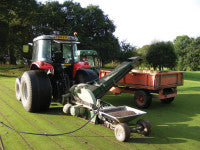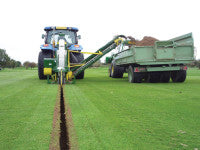Hard times? Need drainage? Cut costs, don’t cut corners
 When times are hard, one activity that often gets put aside is attention to land drainage - and this is unwise, for drainage problems rapidly compound themselves.
When times are hard, one activity that often gets put aside is attention to land drainage - and this is unwise, for drainage problems rapidly compound themselves.
So, if finance is tight, but drainage is essential, how can the two be reconciled?
The answer is relatively simple - work in the most efficient and effective manner. How?
One needs to use today's high output sports turf drainage machines in optimum soil conditions. This entails planning ahead and stressing to the senior management that soil conditions, and not the calendar, must determine when work is undertaken.
A trenching machine, for example, working in the late spring, summer or early autumn may have an output per day double or even treble that of the same machine working in wet soils in winter. And, seeing that there will be provision for supporting equipment, and of the order of five operators on site, savings are substantial.
The subject of trenching leads on to pipe size - one tends to think that bigger must be better, but this is not so. In removing excess soil water, fine particles enter the pipe. There must be a good flow of water through the pipes to carry these 'fines' away. Too big a pipe and the flow of water is sluggish and 'fines' build up, in effect reducing the size of the pipe.
 For optimum results, the pipes should fit snugly in the trenches; for example an 80mm pipe would fit into a trench cut 97mm wide.
For optimum results, the pipes should fit snugly in the trenches; for example an 80mm pipe would fit into a trench cut 97mm wide.
The latent force in the soil reduces the trench width almost immediately it has been excavated.
In turn, this degree of precision leads to savings in the backfilling aggregates. Placing gravels and sands in narrow trenches, without contaminating the surface, has been one of the slowest parts of the drainage activity. But now, there are machines, such as the Fast-Flow range of backfilling hoppers, that enables placement of these materials at speeds of 5-6 mph.
Minimum disruption to the playing surface must be a high priority, for it is costly to undertake repairs, re-turfing and collecting spilled soil. This entails using modern, dedicated sportsturf drainage machinery, rather than something cheap and cheerful, or even doing it by hand.
Secondary drainage schemes are usually superimposed over the primary piped system to enhance the speed of drainage. For years, sand slitting was the only option. 50mm wide trenches were dug 250-300mm deep, then backfilled with gravel and topped with sand or rootzone. 
These slits worked well, but had drawbacks. Often, in dry weather, they opened-up due to soil shrinkage, and the aggregates in the trench needed topping-up. Sometimes, this could occur more than once, prolonging the scarring of the surface and adding additional costs.
Hence, gravel band drainage has become a popular secondary system. It is a trenchless technique, meaning that soil is not excavated; the aggregate is vibrated into 25mm wide slots made by a stainless steel channel opener. Using a 3-tonne capacity gravel banding machine, operated by a skilled operator, outputs of up to 10,000 linear metres per day are usual. In the case of gravel banding, it needs to be undertaken when soil moisture levels are high, as they may be in winter time. The flotation tyres on the machines rarely mark the sward.
Another recently launched secondary system is the Lightening DrainTM. 25mm diameter land drainage pipe is fed into 35mm wide trenches and simultaneously backfilled with Lytag, a manufactured product derived from pulverised fuel ash from coal fired power stations. At pipe spacings of 400-500mm it provides rapid drainage and is finding favour for drainage of established golf greens. At somewhat wider spacings, it may be used to drain football and hockey pitches.
Along with considering what drainage techniques are appropriate, one has to consider by whom they are to be undertaken. Is it best to use a contractor? Would it be appropriate to purchase the equipment? Could equipment be hired-in and used by our own staff? Or, is it feasible to hire-in the equipment together with a skilled operator?
The answer will probably depend on availability of staff, and the skills of those staff. Sometimes, there is a choice of a hybrid approach - for example, hire with the option to purchase. Another approach is to engage a contractor to install the more complex primary drainage system and carry out the secondary drainage with one's own staff.
It's time well spent to make cost comparisons of the alternative approaches, for this is where substantial sums of money can be saved. Take advice. You may find you can afford that drainage work after all.
David Shelton is Managing Partner of Shelton Sportsturf Drainage Solutions LLP. www.sheltonsdranage.com
